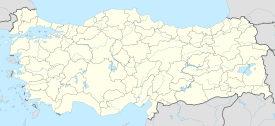Ephesos
| Ἔφεσος Efes |
|

The Library of Celsus in Ephesus
|
|
| Location | Selçuk, İzmir Province, Turkey |
|---|---|
| Region | Ionia |
| Coordinates | 37°56′28″N 27°20′31″E / 37.94111°N 27.34194°ECoordinates: 37°56′28″N 27°20′31″E / 37.94111°N 27.34194°E |
| Type | Ancient Greek Settlement |
| Area | Wall circuit: 415 ha (1,030 acres) Occupied: 224 ha (550 acres) |
| History | |
| Builder | Attic and Ionian Greek colonists |
| Founded | 10th century BC |
| Abandoned | 15th century AD |
| Periods | Greek Dark Ages to Late Middle Ages |
| Site notes | |
| Excavation dates | 1863–1869, 1895 |
| Archaeologists | John Turtle Wood, Otto Benndorf |
| Website | Ephesus Archaeological Site |
| Type | Cultural |
| Criteria | iii, iv, vi |
| Designated | 2015 (39th session) |
| Reference no. | 1018 |
| Region | Asia Minor |
Ephesus (/ˈɛfəsəs/;Greek: Ἔφεσος Ephesos; Turkish: Efes; ultimately from Hittite Apasa) was an ancient Greek city on the coast of Ionia, three kilometres southwest of present-day Selçuk in İzmir Province, Turkey. It was built in the 10th century BC on the site of the former Arzawan capital by Attic and Ionian Greek colonists. During the Classical Greek era it was one of the twelve cities of the Ionian League. The city flourished after it came under the control of the Roman Republic in 129 BC.
The city was famed for the nearby Temple of Artemis (completed around 550 BC), one of the Seven Wonders of the Ancient World. Among many other monumental buildings are the Library of Celsus, and a theatre capable of holding 25,000 spectators.
Ephesus was one of the seven churches of Asia that are cited in the Book of Revelation. The Gospel of John may have been written here. The city was the site of several 5th century Christian Councils (see ).
...
Wikipedia

